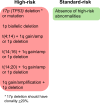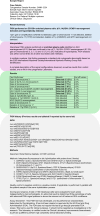Guidelines for the testing and reporting of cytogenetic results for risk stratification of multiple myeloma: a report of the Cancer Genomics Consortium Plasma Cell Neoplasm Working Group
- PMID: 40533444
- PMCID: PMC12177088
- DOI: 10.1038/s41408-025-01286-w
Guidelines for the testing and reporting of cytogenetic results for risk stratification of multiple myeloma: a report of the Cancer Genomics Consortium Plasma Cell Neoplasm Working Group
Abstract
Fluorescence in situ hybridization (FISH) remains the gold-standard clinical assay to detect genetic abnormalities in multiple myeloma (MM). However, FISH panel design, use of conventional chromosome banding analysis and reporting practices have been reported to vary among laboratories. Therefore, standardization in FISH testing and reporting practices is needed to improve report clarity and avoid misinterpretation. The recommendations in this paper represent a consensus of our Cancer Genomics Consortium Plasma Cell Neoplasm Working Group, comprising a joint panel of cytogenetic laboratory directors and clinical investigators with expertise in the diagnosis, risk stratification, and treatment of multiple myeloma. Prior to developing these consensus recommendations, we performed a full literature review and conducted a survey of 102 oncologists to assess current variations and challenges in MM cytogenetic/FISH testing and reporting. Our guidelines establish best practices for the optimization of FISH panel selection, and recommendations for standardized reporting of cytogenetic results to align with the 2025 International Myeloma Society (IMS)/International Myeloma Working Group (IMWG) Updated Risk Stratification.
© 2025. The Author(s).
Conflict of interest statement
Competing interests: EA reports consultancy AbbVie. RB reports consultancy Adaptive Biotech, BMS, Caribou Biosciences, Genentech, Janssen, Karyopharm, Legend Biotech, Pfizer, Sanofi, SparkCures; Research: Novartis, Pack Health. RF reports consultancy for AbbVie, Adaptive Biotechnologies, AMGEN, AZeneca, Bayer, Binding Site, BMS (Celgene), Millenium Takeda, Jansen, Juno, Kite, Merck, Pfizer, Pharmacyclics, Regeneron, Sanofi; scientific advisory boards for Adaptive Biotechnologies, Caris Life Sciences, Oncotracker; board of directors for Antegene, AZBio; and patents for FISH in myeloma. SK reports consultancy from BMS/Celgene, Takeda and Janssen and research funding from BMS (Celgene), Takeda, Novartis, AbbVie, Janssen and Amgen. LBB reports consultancy Genentech. The remaining authors have no interests to disclose.
Figures




References
-
- Kumar SK, Rajkumar SV. The multiple myelomas - current concepts in cytogenetic classification and therapy. Nat Rev Clin Oncol. 2018;15:409–21. - PubMed
-
- Saxe D, Seo EJ, Bergeron MB, Han JY. Recent advances in cytogenetic characterization of multiple myeloma. Int J Lab Hematol. 2019;41:5–14. - PubMed
-
- Avet-Loiseau H, Davies FE, Samur MK, Corre J, D’Agostino M, Kaiser MF, et al. International Myeloma Society/International Myeloma Working Group Consensus Recommendations on the Definition of High-Risk Multiple Myeloma. J Clin Oncol. 2025; In Press. https://healthtree.org/myeloma/community/articles/ims-2024-high-risk-mm-.... - PubMed
Publication types
MeSH terms
Grants and funding
LinkOut - more resources
Full Text Sources
Medical

